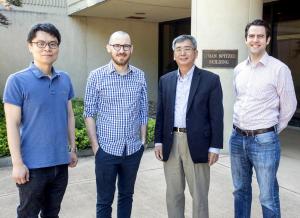The physics behind the transition to H-mode
22 May 2017
H‐mode—or the sudden improvement of plasma confinement in the magnetic field of tokamaks by approximately a factor of two—is the high confinement regime that all modern tokamaks, including ITER, rely on.
PPPL physicists Seung-Hoe Ku, Robert Hager, Choong-Seock Chang, and Randy Michael Churchill. (Photo by Elle Starkman)
It was observed for the first time rather by accident (read more here) and to this day the physics behind H-mode remains not fully understood.
Scientists at the Princeton Plasma Physics Laboratory (PPPL) in the US have made a step in the direction of elucidating the phenomenon by simulating, for the first time, the spontaneous transition of turbulence at the edge of a fusion plasma to H-mode.
The research was achieved with the extreme-scale plasma turbulence code XGC developed at PPPL in collaboration with a nationwide team. This massively parallel simulation, which reveals the physics behind the transition, utilized most of a supercomputer's power—running for three days and using 90 percent of the capacity of Titan at the Oak Ridge Leadership Computing Facility (the most powerful supercomputer for open science in the US).
"After 35 years, the fundamental physics of the bifurcation of turbulence into H-mode has now been simulated, thanks to the rapid development of the computational hardware and software capability," said C.S. Chang, first author of the April Physical Review Letters paper [118, 175001 (2017)] that reported the findings. Co-authors included a team from PPPL, the University of California, San Diego, and the MIT Plasma Science and Fusion Center. Seung-Hoe Ku of PPPL performed the simulation.
Read the full report by John Greenwald on the PPPL website.


